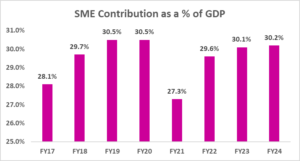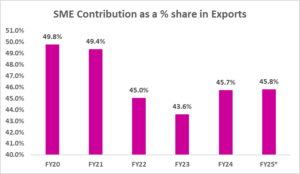IPO is a Milestone for many small and medium enterprises (SME) in India, not only for financial success, but also for recognition of the company and its potential for the future. These SMEs contribute ~ 30% of India’s GDP, 46% of total exports in FY24, and over 110 million people are employed by them. These enterprises can scale their operations and drive expansion by tapping into public markets. However, there is a need to approach the process with a plan and the right execution. Here’s how SME IPO can maximize this transformative opportunity.


What is an SME IPO?
SME IPOs enable smaller companies to raise capital through public markets with relaxed listing requirements. These offerings are characterized by smaller issue sizes, simplified compliance norms, and dedicated trading platforms (BSE SME and NSE Emerge) tailored to support the growth of emerging businesses.
This platform offers a regulatory way for SMEs to access public funding, benefiting from reduced regulatory burdens. After the IPO ends, SME stocks are traded on the stock exchange. Public investors can become stakeholders in the SME by buying their shares.
1. Understand the SME IPO Landscape in India
Currently, India’s SME IPO ecosystem is booming with exchanges like the BSE, SME and National Stock Exchange Emerge platforms listing smaller enterprises. As of 23rd Jan 2025, 549 companies have been listed on the SME platforms and have raised more than ₹8,254 crores. The average IPO size has been between ₹5 crore to ₹25 crore which makes SME IPO accessible for the SMEs to raise the required funds.
Source – BSE SME and NSE Emerge platform reports, 2023
2. Articulate competitive advantage of the company
-
- High Growth Potential: Describe how the funds will be strategically utilized for big opportunities for expansion, innovation, and market penetration.
- Scalability: Describe the business model as linear and scalable, with low incremental costs, modular processes, and technology-driven efficiencies. Also highlight factors like operations, supply chains, and integrations that support the ability to continuously grow at scale.
- Competitive Moat: Highlight what sets your business apart and gives you a lasting advantage over competitors. This could include proprietary technologies, exclusive partnerships, loyal customers, or a strong, trusted brand. Share how your innovations, ability to scale efficiently, or specialized know-how create barriers that make it harder for others to compete.
3. Strengthen Your Financial Health
A strong financial foundation is the cornerstone of a successful IPO. The following is what we need to focus on:
- Revenue Growth: Investors always prefer consistent revenue growth. Based on our analysis, we have noticed that the top 100 SMEs have achieved a compound annual growth rate (CAGR) of 39% over the past 3 years.
- Profitability: A positive bottom line is very important for an SME which showcases margins that are competitive within that industry. For instance, SMEs in the industrial sector often have PAT margins of around 10%.
- Debt Management: Keep your debt-to-equity ratio below 0.5:1 to signal financial stability. High leverage can deter investors.
4. Ensure Compliance and Corporate Governance
Regulatory compliance and governance practices are a must which are non-negotiable for an SME IPO. Ensure:
- Audit Readiness: Conduct at least three years of audited financial statements, which a trusted auditor with an unqualified opinion should prepare.
- Corporate Structure: Have a clear shareholding pattern with no disputes. Promoters’ stake should ideally remain above 65% post-IPO as further QIB rounds might lead to further dilution.
- SEBI Requirements: Meet the eligibility criteria for SME IPOs, such as net tangible assets of at least ₹3 crore in the last preceding (full) financial year and a minimum average pre-tax profit of ₹1 crore in the last three years.
- FCFE Regulation about NSE Emerge: SMEs planning to list on NSE Emerge will have to show positive Free Cash Flow to Equity (FCFE) for at least two of the last three full financial years. This requirement applies to Draft Red Herring Prospectuses (DRHPs) submitted on or after September 1, 2024.
5. Assemble a Strong IPO Team
Collaborate with experts to navigate the complexities of an IPO. Your team should include:
- Merchant Bankers-The first step in starting the IPO process is to bring a merchant banker on board. Also known as an underwriter, they are professionals who understand market trends and investor expectations, guiding you through the journey.
- Prepare DRHP -: The DRHP enables potential investors to evaluate the company’s financial data and assess the market, helping them make informed investment decisions. The Underwriter prepares this document.
- Submit DRHP -: When filing a regular IPO, Companies submit the DRHP to SEBI. For SMEs, however, the DRHP must be submitted to and verified by the Stock Exchange.
- Legal Advisors: Ensure compliance with SEBI regulations and draft the prospectus meticulously.
- Auditors: The company needs a peer review-certified auditor.
6. Advertise the IPO and focus on Investor relations
After the Stock Exchange approves the draft, the underwriters finalize details such as the IPO opening and closing dates, the issue price, and other specifics, and then schedule the IPO launch. At this stage, only the underwriters, banks, and stock exchange are aware of the company’s plan to go public. The next step involves promoting and marketing the IPO to attract public investors by
- Investor meetups – Host roadshows in key financial hubs to connect with institutional and retail investors while highlighting the company’s growth potential.
- Transparent Communication – Address concerns openly.
7. Post-IPO Strategy
Your responsibilities don’t end after the IPO. Focus on:
- Efficient Utilization of Funds: Deliver on the promises made during the IPO by deploying capital judiciously.
- Ongoing Compliance: Maintain quarterly reporting and adhere to governance norms.
- Investor Engagement: Continue to build relationships through updates and meetings.
Conclusion
Preparing for an SME IPO is a transformative journey. This is the right time to grab this opportunity for growth through India’s capital markets which are offering unprecedented opportunities to SMEs. You should concentrate on financial discipline and compliance to ensure that your company is seen as a viable investment opportunity. Do not forget that a well-executed IPO raises funds and also boosts your company’s brand in the competitive marketplace.












Leave a Reply